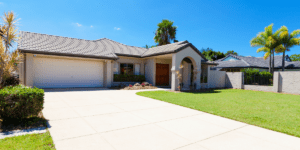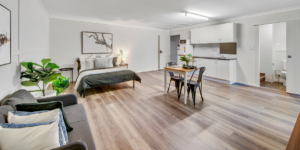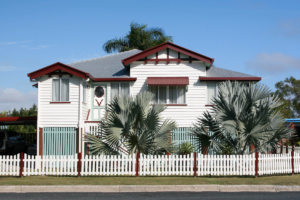Property investment strategies for savvy first home buyers
Even with all the masses of real estate information out there in the world, I’m still seeing people make rookie mistakes on their first property. If we’re going to create a quantum shift in property investment strategies for beginners, it has to start with avoiding these 5 common traps.
Trap number 1: believing your first home has to be your dream home
The average length of time Australians hold onto their first home, or any home, is about 11.8 years. In today’s market, your first property probably isn’t going to be your dream or ‘forever’ home. So you don’t need to fall in love with it; instead, treat it as a stepping stone on the way to your dream.
(To give you some context, I’ve been investing in property for 30 years and I’ve only just built my dream home.)
Long-term capital growth and being able to re-finance to increase your portfolio are how you’ll build your wealth. One of the goals with your first investment in property then, especially in a booming market, should be that it’s strong enough to lead you into a second investment.
I call it the “base ingredient of your portfolio cake” – it’s the butter and the flour, with the icing being the dream-home goal at the end.
So where to buy? Choose a suburb with high growth potential – a warm/cool spot is my recommendation. Because you’re treating it as a rational, business decision, not an emotional or personal one, it possibly won’t be in your favourite suburb; or even in the town or state where you live.
You’re looking for the potential for healthy growth over the long term, wherever that may be.

Trap number 2: buying a unit or property in a low-density area
There are two types of growth: capital growth as we mentioned above, and manufactured growth – the ability to make changes that increase its value.
I’ve spoken before about avoiding investing in greenfield estates near farmland because of the way capital growth is limited. Buying in a unit block has its own set of drawbacks as I’ve outlined below.
- Despite the thousands of unit blocks dotted around the country, many Australians aren’t ready to live vertically. At heart they want to live horizontally with grass between their toes when they step outside – the Great Australian Dream. We’re still about 15 years away from thinking of apartments as the norm, like they do in some other countries.
- Units don’t give the same control over your property as houses do. The strata or body corporate will probably have some say over what you can do in the way of improvements to the property. If you want to change your floor plan for instance, the committee might put the kibosh on it. Ultimately you’re beholden to them.
- Off-the-plan units, where you’re signing up for a property that hasn’t been built yet, has its own dangers, mainly because the builder or developer is relying on yours and other people’s signatures to get funding for the property. Ultimately the unit’s value could end up being lower than the amount you’ve agreed to pay.
- Strata or body corporate fees can be quite hefty, especially if you have landscaped gardens, pools or lifts.
- You potentially have to contribute to extra levies if the strata votes to invest in major improvements or upgrades to the building or surrounds.
- When someone in your unit complex is in financial distress and sells their unit cheaply, it can potentially lower the value of your unit, regardless of the condition yours is in.
Similarly, if you ask me whether it makes sense to invest in areas zoned as low-density, I say no because of the lack of flexibility: these properties don’t give you broad scope for increasing value through adding more dwellings and subdividing.
THINK YOU CAN’T AFFORD TO BUY A HOUSE? Scroll down to learn my adaptability strategy to enable you to cash in on a property that will enable you to buy your first home faster!

Trap number 3: not seeing the full potential for adaptability in a property
The family home I’ve built in Noosa – our dream home, has been designed so it can also be used for co-living, or as a wedding venue. We had specific purposes and outcomes in mind when we made the decision to buy.
So applying my logic to your first home: even if it’s a standard Australian brick box, what are the options for adapting the property to give exceptional returns that are well above that of a normal property?
As an example, could your four-bedroom house be divided up into a separate studio, one-bedroom apartment and two-bedroom apartment, by reconfiguring the internal spaces? And could you and your partner live in the studio and rent out the rest to get more cashflow?
And if you then have a child (or two), could you move into one of the bigger units and rent out the others, gradually taking over the whole house as you need to? But then as your children move out, could you reverse that, renting out the spare units as children fly the nest?
This idea is part of a wider mindset of generational co-housing and community building I call ‘Circle of life’ – watch my Circle of Life video for more detail. This thinking means that as your family situation evolves over time, as you buy and build property, you always have rental income helping pay down your debt.
Are you in your 20s or 30s and facing a shortage of affordable homes? You need to be thinking now about how you can pay your home off more quickly by using these property investment strategies.
If you go in with this mindset, then you’ve given yourself opportunities to leverage your first property to get to a better home, and then an even better one down the track – and so on.
CHECK OUT the success story of my students Brian and Lisa who turned a single family home into co-living micro-apartments and uplifted their rental return by over $45K per year!

Trap number 4: leaping on government grants as quickly as you can
With your first property, it’s tempting to grab any first home buyer’s grant or stamp duty relief you can get your hands on, and plan your purchase around that. But not all grants are created equal, and there’s more financial gain to be made by being strategic.
I’ve seen people use a $25,000 grant to spend $50,000 too much on a property. Taking up a grant might also limit the way you use the property for best returns.
If you don’t buy your first home to live in, but as an investment, most Australian states allow you to access those grants further down the track – even 5 or 10 years later, when you do decide to become an owner-occupier. Check the conditions for your state.
Trap number 5: believing you have to live in the first property you buy
Can’t afford to buy in the area where you ideally want to live? Rather than saving desperately for the next 5 or more years, buy where you can afford as soon as you can, and use the investment income to help pay the rent where you do want to live. It’s known as rentvesting and it’s an increasingly popular strategy for a reason.
The sooner you get into the market and reap the rewards of capital growth and cashflow, the faster you’ll be able to save a deposit for the next one.
LEARN HOW to build a portfolio of properties with a cash flow positive return and own your forever home faster in my NEXT WEBINAR HERE






